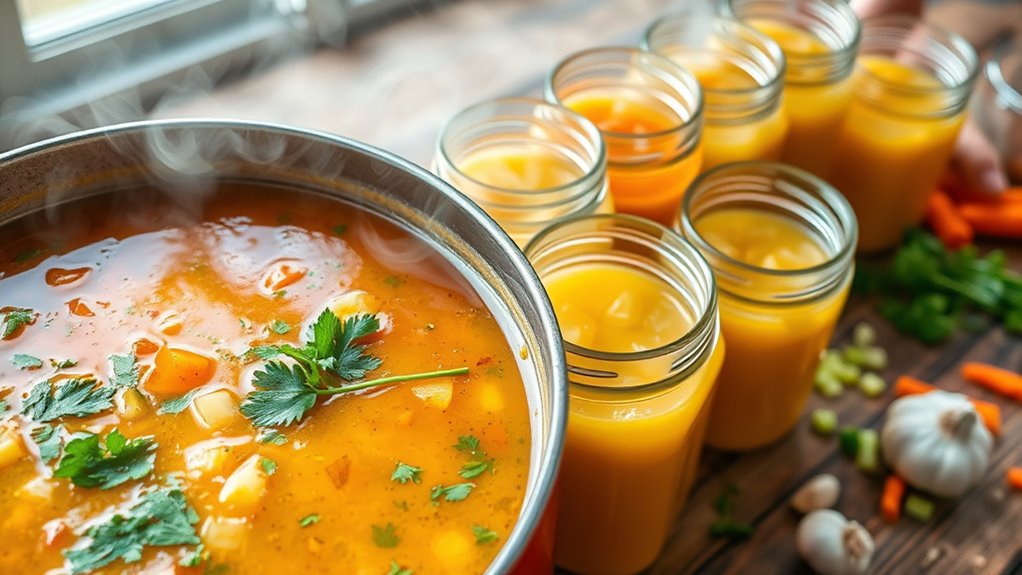To start, gather a turkey carcass, 8 cups cold water, onion, carrots, celery, garlic, bay leaf, salt, and pepper, plus a pressure canner and jars. Rinse remnants, then simmer the carcass with vegetables to build a rich broth, skimming as needed. Remove bones, strain, and season to taste. Pack hot into jars, seal, and process in a pressure canner per recommended times. Proper technique guarantees safety and flavor; keep going to learn more steps and tips.
Ingredients and Quantity
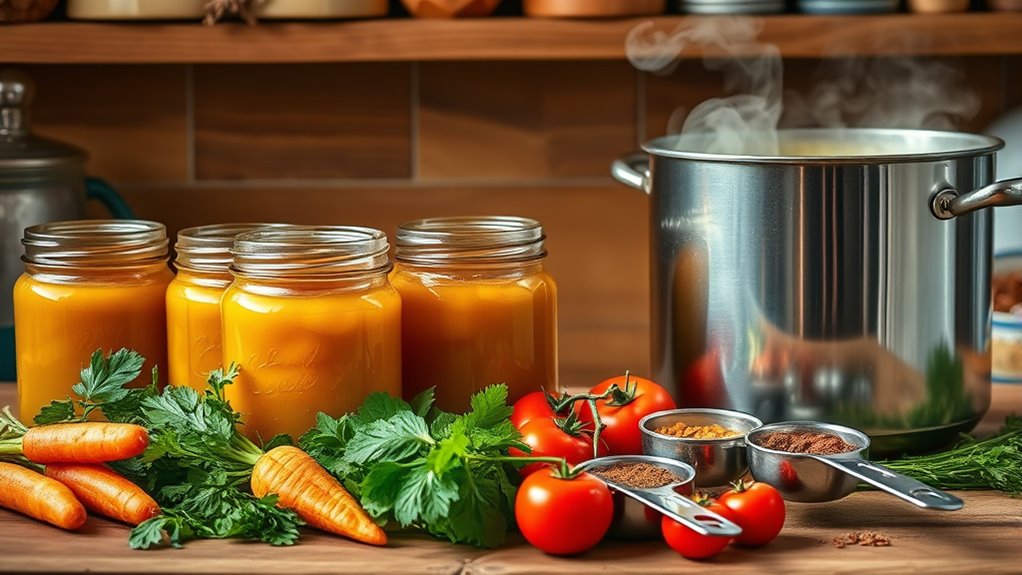
For this turkey soup, assemble the core ingredients and quantities: 1 whole turkey carcass or 2–3 pounds of turkey bones, 8 cups of cold water, 1 large onion (quartered), 2 carrots (sliced), 2 celery stalks (sliced), 2 cloves garlic (crushed), 1 bay leaf, 1 teaspoon salt, and ½ teaspoon black pepper.
| Item | Quantity |
|---|---|
| Turkey parts | Carcass or bones, as above |
| Aromatics | Onion, carrots, celery, garlic, bay leaf |
| Seasoning options | Notes |
| Salt and pepper | Start conservative, adjust after tasting |
This approach stays precise and safety-focused, empowering you to tailor Turkey parts and seasoning options for a clean, freedom-minded simmer.
Preparations
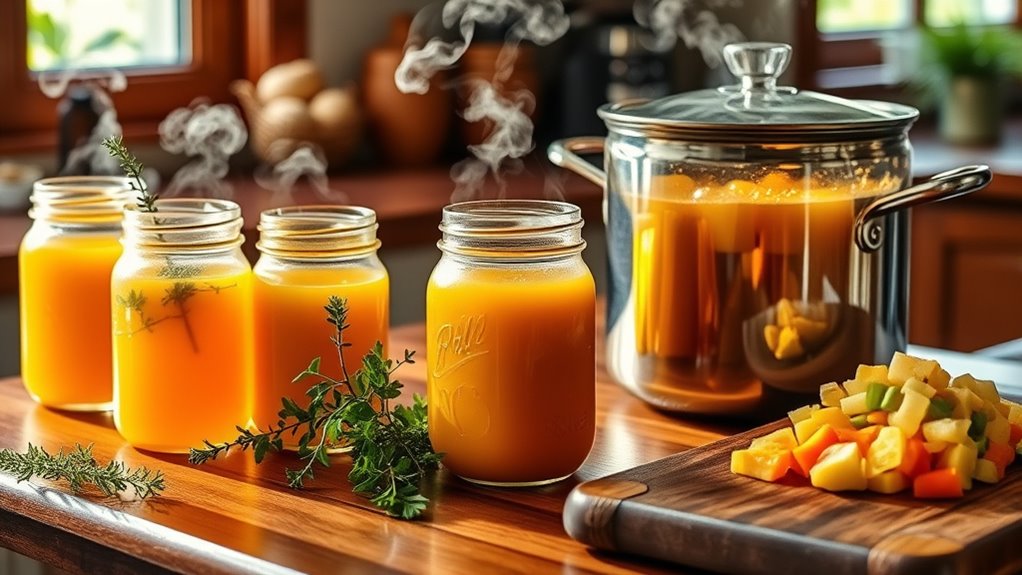
Before you start simmering, do a quick safety and freshness check: remove any packaging remnants, rinse the turkey carcass or bones under cold water, and verify your pot and utensils are clean. In the Preparations phase, you focus on clean, organized workflow. Confirm you have measured portions ready, label containers, and plan sequence to minimize heat exposure. Apply preparation techniques that emphasize cold handling for any raw components and thorough rinsing of produce, if used. Choose ingredients with aroma and flavor depth to support canning stability. For ingredient selection, prioritize lean meat, bones for gelatin, and compatible herbs. Maintain steady, clean surfaces and deliberate movements. This mindset guarantees predictable results, reduces risk, and respects your freedom to craft safe, delicious turkey soup.
Kitchen tools or Kitchenware Required
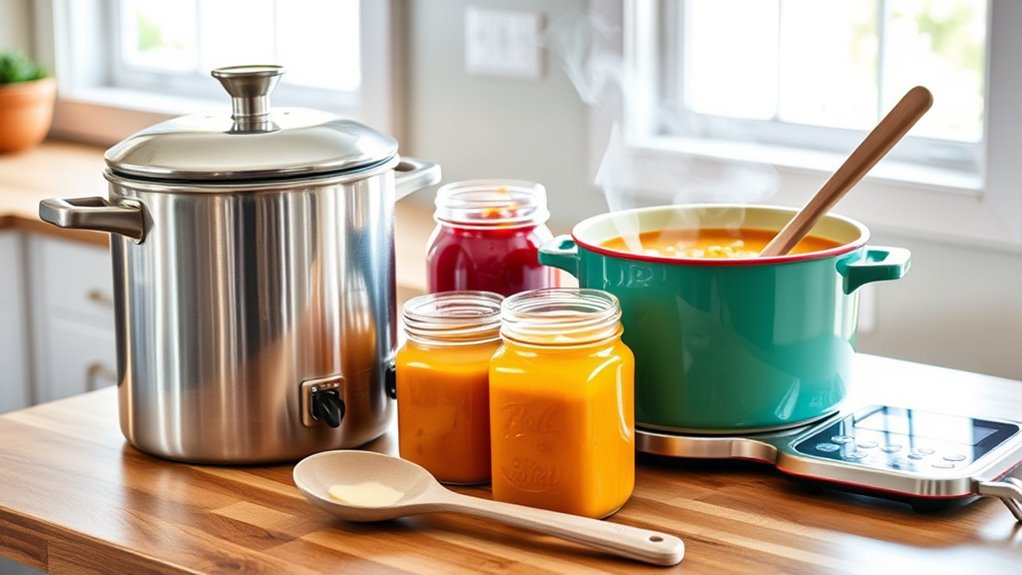
A well-equipped kitchen makes the simmering stage safer and easier, so gather sturdy tools you can rely on: a large, heavy-bottom pot with a tight-fitting lid, a sharp chef’s knife for prep, a formidable cutting board, a sturdy ladle for skimming and serving, and a slotted spoon to remove solids without losing broth. You’ll rely on canning equipment and essential utensils to maintain control during processing. Use this table as a quick reference for core items:
| Category | Example |
|---|---|
| Canning equipment | Pressure canner, canning jar lifter |
| Essential utensils | Tongs, funnel, silicone spatula |
How to Cook

- Assemble all ingredients and necessary equipment.
- Set up a clean, organized workspace.
- Thaw turkey if needed, ensuring safe handling practices.
- Wash hands thoroughly and sanitize all surfaces.
- Slice vegetables into uniform sizes for even cooking.
- Measure broth, seasonings, and aromatics precisely.
- In the pot, render any fat over medium heat.
- Sweat onions, celery, and carrots until translucent.
- Add turkey meat, broth, and water to the pot to achieve a gentle simmer.
- Maintain steady heat to avoid boiling; skim foam as it forms.
- Control temperature carefully to preserve the turkey’s texture.
- Adjust salt and pepper gradually to taste.
- Practice patience during cooking; do not rush reductions.
- Taste periodically, aiming for balanced flavor without overpowering salt.
- Enhance flavor with fresh herbs and a light simmer, preserving clarity of turkey taste.
How to Serve
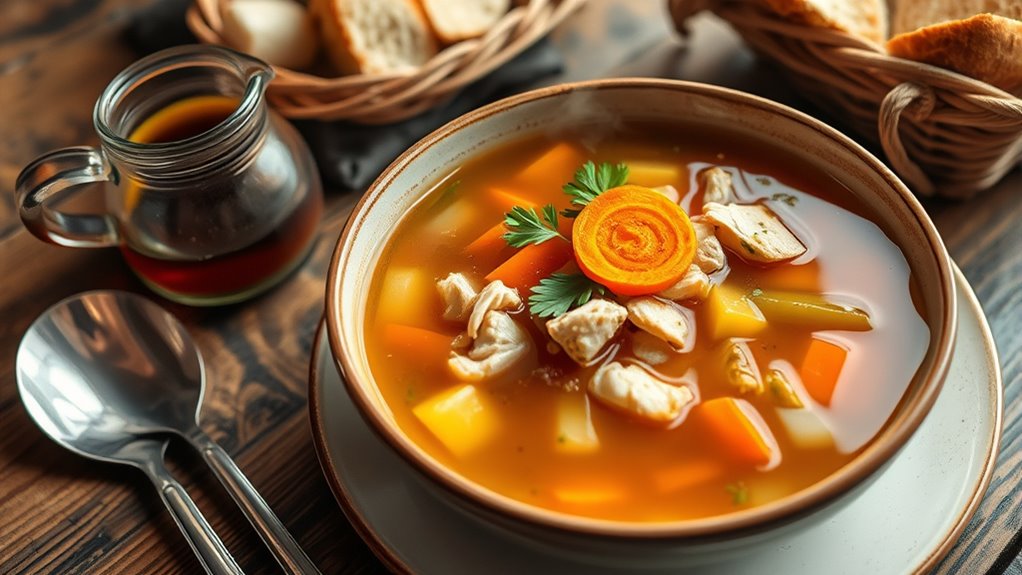
When serving, keep the turkey soup hot but not boiling, maintaining a steady simmer to preserve clarity and texture. You’ll plate with purpose: ladle into bowls, leaving a clear broth and tender vegetables visible. Add protein last to prevent shredding, then adjust salt and pepper to taste. Use clear, heatproof bowls and pre-warmed spoons to maintain temperature. For serving suggestions, offer crusty bread, crackers, or a light squeeze of lemon to brighten richness. Consider a simple garnish like parsley or a thin carrot coin for color without clouding the broth. Presentation ideas include arranging bowls on a warmed tray, aligning spoons, and presenting a small pitcher of extra broth on the side. Keep safety in mind: reheated portions shouldn’t exceed safe holding times.
Tips
To keep turkey soup flavorful and safe, start with a clean mise en place: have broth hot but not boiling, ready-to-eat vegetables prepped, and protein added at the end to avoid shredding. In the canning process, follow tested procedures, monitor headspace, and adjust processing times for altitude. Use canning techniques that guarantee seals, then label jars with date and contents for traceability. For flavor enhancements, keep salt modest during processing and finish with a bright finish after cooling; add herbs, pepper, or citrus zest just before serving. Maintain strict cleanliness, sanitize tools, and work quickly to minimize contamination risk. Store in a cool place, rotate stock, and verify seals before storage. Consistency and safety empower confident home canning.
Food Value and Benefit
Turkey soup offers valuable nutrition that supports overall health, recovery, and hydration. This hearty dish combines protein, vitamins, minerals, and fluids to keep you energized and satisfied between meals. The broth is rich in electrolytes and minerals like potassium, sodium, and magnesium, which help replenish the body after physical activity or illness. Vegetables included in the soup contribute essential vitamins such as vitamin A, vitamin C, and B-complex vitamins, along with dietary fiber that aids digestion. When canned properly, turkey soup retains these nutrients safely, making it a reliable and nutritious option for your pantry.
Turkey soup nourishes with protein, electrolytes, and vibrant vegetables for recovery and comfort.
Benefits of eating turkey soup:
- Provides high-quality protein essential for muscle repair and recovery
- Supplies important minerals like potassium, sodium, magnesium, and phosphorus to maintain electrolyte balance and support hydration
- Delivers vitamins A, C, and B-complex to boost immune function and promote overall health
- Contains dietary fiber from vegetables to support healthy digestion
- Warm broth enhances nutrient absorption and offers soothing comfort
- Safe canning preserves nutrient quality and extends shelf life, reducing food waste
- Balanced portions help sustain steady energy levels and aid recovery during illness or after exercise
Frequently Asked Questions
How Long Is Turkey Soup Safe After Canning?
You should refrigerate or freeze turkey soup promptly; canned soup remains shelf-stable only as long as the seal stays intact and stored properly. For safety, follow canning guidelines; labeled shelf life varies, and food safety requires caution.
Can I Reuse Jars With Hermetic Seals?
Yes, you can reuse jars, but inspect for cracks and loss of seal. Verify jar sterilization tips are followed and confirm seal integrity importance before reuse; if doubt remains, discard. Maintain safety, measure, and proceed with caution.
Is Pressure Canning Required for Turkey Soup?
Pressure canning isn’t required for all turkey soups, but it’s essential for low-acid ingredients and long-term storage. You’ll guarantee turkey safety by following tested guidelines, using pressure canning when needed, and avoiding improvised methods.
What Is the Recommended Headspace for Cans?
The recommended headspace is 1 inch for both pints and quarts. Follow canning guidelines precisely, leaving space for expansion. Maintain safety by adjusting if needed, and never improvise. You’ll preserve with confidence when you measure accurately.
How to Fix Seal Failure on Canned Soup?
To fix a seal failure, inspect for cracks, reprocess with fresh lids, and re-can using proper headspace. Seal troubleshooting: verify cleanliness, follow canning tips, monitor processing time, and store safely for maximum preservation and safety.
